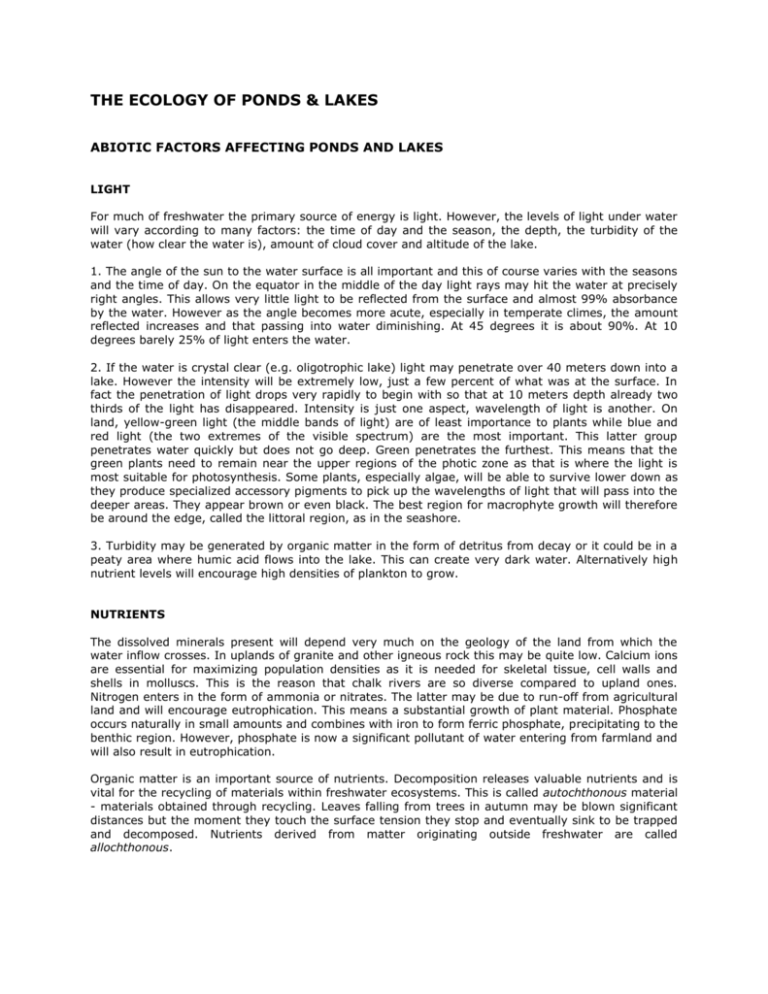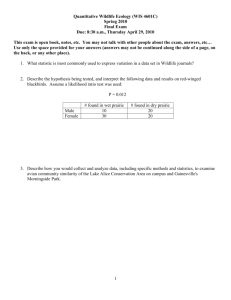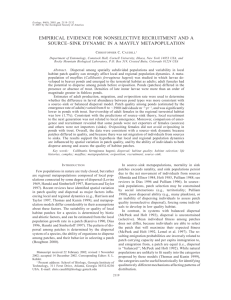THE ECOLOGY OF PONDS & LAKES
advertisement

THE ECOLOGY OF PONDS & LAKES ABIOTIC FACTORS AFFECTING PONDS AND LAKES LIGHT For much of freshwater the primary source of energy is light. However, the levels of light under water will vary according to many factors: the time of day and the season, the depth, the turbidity of the water (how clear the water is), amount of cloud cover and altitude of the lake. 1. The angle of the sun to the water surface is all important and this of course varies with the seasons and the time of day. On the equator in the middle of the day light rays may hit the water at precisely right angles. This allows very little light to be reflected from the surface and almost 99% absorbance by the water. However as the angle becomes more acute, especially in temperate climes, the amount reflected increases and that passing into water diminishing. At 45 degrees it is about 90%. At 10 degrees barely 25% of light enters the water. 2. If the water is crystal clear (e.g. oligotrophic lake) light may penetrate over 40 meters down into a lake. However the intensity will be extremely low, just a few percent of what was at the surface. In fact the penetration of light drops very rapidly to begin with so that at 10 meters depth already two thirds of the light has disappeared. Intensity is just one aspect, wavelength of light is another. On land, yellow-green light (the middle bands of light) are of least importance to plants while blue and red light (the two extremes of the visible spectrum) are the most important. This latter group penetrates water quickly but does not go deep. Green penetrates the furthest. This means that the green plants need to remain near the upper regions of the photic zone as that is where the light is most suitable for photosynthesis. Some plants, especially algae, will be able to survive lower down as they produce specialized accessory pigments to pick up the wavelengths of light that will pass into the deeper areas. They appear brown or even black. The best region for macrophyte growth will therefore be around the edge, called the littoral region, as in the seashore. 3. Turbidity may be generated by organic matter in the form of detritus from decay or it could be in a peaty area where humic acid flows into the lake. This can create very dark water. Alternatively high nutrient levels will encourage high densities of plankton to grow. NUTRIENTS The dissolved minerals present will depend very much on the geology of the land from which the water inflow crosses. In uplands of granite and other igneous rock this may be quite low. Calcium ions are essential for maximizing population densities as it is needed for skeletal tissue, cell walls and shells in molluscs. This is the reason that chalk rivers are so diverse compared to upland ones. Nitrogen enters in the form of ammonia or nitrates. The latter may be due to run-off from agricultural land and will encourage eutrophication. This means a substantial growth of plant material. Phosphate occurs naturally in small amounts and combines with iron to form ferric phosphate, precipitating to the benthic region. However, phosphate is now a significant pollutant of water entering from farmland and will also result in eutrophication. Organic matter is an important source of nutrients. Decomposition releases valuable nutrients and is vital for the recycling of materials within freshwater ecosystems. This is called autochthonous material - materials obtained through recycling. Leaves falling from trees in autumn may be blown significant distances but the moment they touch the surface tension they stop and eventually sink to be trapped and decomposed. Nutrients derived from matter originating outside freshwater are called allochthonous. OXYGEN The lower the temperature the higher is the saturation of oxygen. Conversely the warmer the water gets the lower the amount of oxygen that can dissolve in it. Oxygen is essential for most of the life in freshwater. Some will be able to live anaerobically in the mud. They may either be permanent anaerobes, e.g. some types of bacteria, while others may be able to survive short periods without oxygen, e.g. chironomid larvae. But the majority of organisms need a steady supply of oxygen and if the temperatures rise this will be a problem. Even when it is fully saturated water contains little oxygen. At 5 degrees (and at normal air pressure) one liter of water contains only 8.9 cc oxygen and at 20 degrees it contains 6.4 cc. At higher altitudes this lessens but the lowering level of oxygen may be compensated for by the reduction in temperature that allows a higher amount to saturate the water. The amount of oxygen consumed by animals will increase as temperature rises. The rate of decomposition within the benthos will be determined by the amount of oxygen present. In oligotrophic lakes the oxygen levels may well be moderately high in the benthos compared to eutrophic ones that can be deoxygenated. pH pH can vary enormously between ponds and lakes, due to bedrock, topography and even the species of plant present. For example on heath lands where ponds form there are likely to be Sphagnum or bog mosses present. These actively exchange ions across their cell walls. As they take in minerals they compensate by releasing hydrogen ions which increase the acidity. The most significant aspect to pH is the amount of carbonic acid present. Carbon dioxide dissolves in water to produce this and so it is a measurement of the level of C0 2 available for photosynthesis. The ions dissociate to yield hydrogen and hydrogen carbonate. Measurement of the pH of a pond over a 24 hour period will demonstrate this well. At dawn the water will be acidic due to the high level of carbon dioxide released through respiration by all the living organisms present. However, as the sunlight becomes available photosynthesis occurs and the level of carbon acid declines. By mid-day the water may become increasingly alkaline until the sun sets. With the reduction in light photosynthesis halts and only respiration occurs in the organisms. pH decreases accordingly. In regions rich in calcium the hydrogen carbonate combines with the calcium to form chalky deposits on plants so that species like the stoneworts thrive. Some animals – such as crayfish – are specific to calcium-rich, alkaline water. Snails need calcium for their shells and so will be limited to water rich in this mineral. Plankton may also be specific to alkaline waters. Acidification of lakes through acid rain can completely destroy the communities present. TEMPERATURE Temperature is one of the major factors affecting freshwater ecosystems. Compared with other systems, freshwater systems have a high heat storage capacity, which means that between the seasons there is a minimum of impact compared with terrestrial ecosystems. The main effects of temperature are: 1. distribution of organisms both seasonally and vertically through the water and 2. behavior and reproduction of organisms. The reason that organisms are affected by temperature is largely due to the fact that they are cold blooded or poikilothermic. The external environment will determine their internal temperature and therefore metabolic activity. Above 4 degrees Celsius the density of water get progressively lower. The most noticeable effect of this will be on the plankton. Increases in temperature above 20 degrees will make them considerably less buoyant and they will be more likely to sink. Most aquatic invertebrates are sensitive to changes in temperature and therefore density. Being cold-blooded their metabolic rate will slow down as the temperature drops. Those needing to be active early in the year may be dark in color. The large red damselfly is one of the first insects to emerge in the spring. It has a great deal of black on the body and a melanic (dark) form is fairly common. This will absorb a maximum of warmth. Thermal Stratification The water in a pond and lake is warmed by solar energy. If the pond is very shallow there could be a substantial increase in temperature over a diurnal period with cooling at night. With the high heat storage capacity the larger the water body the less effect the sun will have over the day. However, the upper region of a lake will warm in the sun and, if wind turbulence is low, an underlying cool layer will be present. This is thermal stratification and is very important in determining other abiotic and biotic factors. Remembering that very cold water is at its most dense the warm water at the surface (called the epilimnion) will be least dense and "float" over this substantially cooler, dense water layer (called hypolimnion). The water between the two will show a rapid change in temperature over a relatively short distance. This sharp change in temperature is called the thermocline. This stratification tends to be present during summer and winter when disturbance is at a minimum. In spring and autumn there is the greatest chance of wind-induced wave action. In turn this creates a greater mixing of the layers and the thermocline is most likely to disappear. The position of the thermocline (the most important physical event in a lake) in any lake will vary according to factors such as size of water body, depth and latitude. Adaptations to Changes in Temperature As mentioned above temperature affects the metabolism of the organism as temperature affects enzyme activity in the body. An enzyme will have an optimal temperature at which it works best. As these enzymes vary it will mean that different organisms will have differing abilities to cope with the variations that exist in ponds and lakes. An organism that can tolerate a wide range of temperatures is called a eurotherm while those with a narrow tolerance range are stenotherms. Fish have been widely studied, as much as anything for commercial reasons. Trout have been shown to have the ability to reproduce if the water is between about 3-14 degrees C with optimal growth between 7-18 degrees C. Above 24 degrees and it becomes lethal. By contrast a Carp reproduces optimally at around 20 degrees C and optimal growth temperature is between 20-30 degrees C. It can tolerate a wide temperature range between 0 and 32 degrees C. These figures are approximate because many organisms have the ability to acclimatize to wider ranges. These different tolerances will vary with algae as well as animals. TURBULENCE While ponds and lakes are classified as static water they are often far from being still. Turbulence caused by the wind can be very influential. It may cause substantial movement in the surface and the prevailing wind direction can easily be determined by looking around a lake. Debris will be moved to particular shores. This wind action creates underwater currents. This will not only move inanimate objects but will be central to distributing the fauna. Strong winds in spring and autumn are also the cause of the breakdown of the thermocline that helps to induce nutrient movement from the benthos. PLANT COMMUNITIES Plant communities can be summarized as being either microphytes or macrophyte. Microphyte consists of the microscopic organisms like algae. This will include the various types of phytoplankton that drift in the water and also those types that attach to stones and the macrophytes. Attached microphytes are called the periphyton and may be joined by bacteria and protists like the amoeba. These minute algal cells may form large growths on the pond weeds. Macrophyte is the name given to the large, easily visible plants. These mainly form communities around the fringe of ponds and lakes. If the water is shallow then the macrophyte may extend right across the water. Otherwise it will be limited to the fringe or littoral region. Here several communities can exist. 1. Plants floating at the surface: e.g. duckweed and frog bit 2. Plants floating beneath the surface and not rooted: e.g. hornwort, pondweed 3. Plants rooted and with leaves floating at the surface: e.g. water lilies 4. Plants rooted but the leaves are erect, out of the water: e.g. bur reed, water plantain, reed mace A Profile down the Edge of a Pond The above are flowering plants but some non-flowering plants may be abundant as well … for example mosses, liverworts, stoneworts, horsetails and water fern. These will fit in with the above four communities or can exist as dense stands in their own right. Fir example, in high alkaline conditions stoneworts will completely dominate the aquatic zone. Mosses and liverworts will be close to the ground where flowering plants are sparse. The water fern can be a pest as it may be found in very high densities covering a pond. The zones of vegetation (1-4 above) may fit the hydrosere. Number 1 will be close to the open water and as the pond becomes increasingly shallow zone number 4 forms a swamp. This fringe vegetation produces abundant shelter for microphytes to colonize and various animal groups, enabling them to avoid predators. ANIMAL COMMUNITIES The plants form a distinct series of zones through the littoral region. The animals may fit this zonation as well but the variety of microhabitats is enormous. The main habitat regions for animals: 1. Epineuston - on the surface film 2. Hyponeuston - beneath the surface film 3. Pelagic Region - open water within the light 4. Profundal Region - below the photic zone so no light 5. Benthos - the bottom. This may be the fringe benthic region (within photic) or profundal benthic region Zones for Animals at the Edge of a Large Pond or Lake The profundal region may not be present as this will depend on the depth. Two groups of animals exist in the pelagic or profundal region: plankton if they drift at the whim of the wind and turbulence; larger animals that have the power to determine their movement between the regions, e.g. fish, are called nekton. Nektonic creatures are often dominated by the fish that move freely between the microhabitats to feed. Pond skaters are a good example of animals living on the surface (epineuston), using surface tension to support themselves. Many of these are predatory bugs but may be eaten by those living beneath the surface like fish and greater water boatmen (Notonecta sp). Whirligig beetles are associated with the surface and can see both above and below as they have two pairs of eyes. However, like many species that live just below the surface they can leave the surface and dive considerable distances. Most invertebrates live either in the fringe weeds or benthos. Fringe Weed: The various shapes and sizes of the weed leaves provide ideal shelter for a huge variety of invertebrates. Hydra and sponges are sedentary creatures that wait for the food to go to them. Mayflies, pond snails and many others remove material like the periphyton from the surface of the macrophyte, often waiting for nightfall before moving around the plants. Predators like damselflies and dragonflies lurk on the plant material waiting for the prey to come within grabbing distance. The larvae of diving beetles are another good example of lurking predators. Benthos: In ponds and the edge of lakes the benthic region can be covered by leaf debris providing huge amounts of nutrient for benthic animals. The water hog louse (Asellus ) is a good example of a detritivore consuming the leaf litter. Others like the worms and flatworms can be found in abundance under the dead leaves. Snails and some bivalves may be here although the larger ones like the swan mussel may be in deeper water. Profundal mud is dominated by sediment and can be more difficult to study with a net because of it. Potentially messy! PREDATION AND FOOD WEBS Primary production is the start of the food web; plants fix energy and carbon into the system through photosynthesis. The food that this generates will in turn be consumed by the herbivorous creatures like mayflies. This second layer of any food web could be described as the secondary production within the ecosystem. It is this group that may be eaten by the carnivores. Ponds have a high level of predators present because of the huge wealth of plant feeders and detritivores. The food web below just gives a general idea of the flow of energy between the different levels. POND FOOD WEB There are five main groups of feeders. Feeding Category Invertebrate Examples Grazers & Scrapers Mayfly larvae, cased caddis fly larvae, pond snail, river limpet Shredders Freshwater shrimp, the smaller stonefly larvae Collector & Gatherers Chironomid midge larvae, worms, some mayflies (e.g. Ephemera Collector & Filterers Black fly larvae and net-spinning caseless caddis fly larvae Carnivores Dragonfly larvae, damselfly larvae, large stonefly larvae and alderfly larvae







